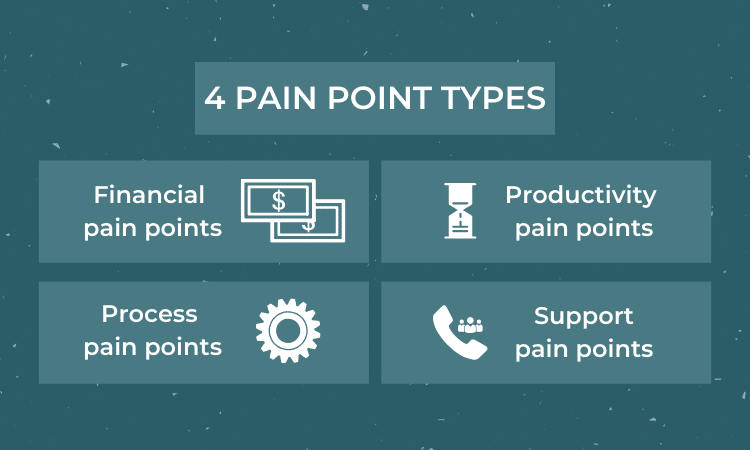How to Identify Customer Pain Points?
Regardless of the business size, providing a satisfying customer experience helps brands stay on top. From complaints about overpriced services and low-quality items to complaints about broken links or poor customer service, organizations should be able to address any customer pain point successfully.
If you are wondering how to identify customer pain points, Here are four approaches to identifying client pain issues if you want to increase customer stickiness for your product or service.
What Are Customer Pain Points?
Customer pain points are issues that customers encounter at various times in their user journey. Customer pain points directly influencing the business are also known as business pain points.
We have classified the most prevalent customer pain points according to their corresponding business domain to identify the customer pain points that could directly impact your organization.
What Are the Different Kinds of Customer Pain Points?
- Support pain points – Support pain points are frequently internal difficulties that prevent firms from swiftly and effectively resolving customer issues as they use products.
- Process pain points – Process pain points can refer to shortcomings in the customer journey. It has an impact not just on your consumers but also on your crew.
- Productivity pain points may reduce agent productivity and the effort to provide customer support. Customers may immediately terminate their association with your brand due to these internal inadequacies, or they may have a higher propensity to churn.
- Financial pain points – Financial pain points are typically the most serious of all client problems. Economic pain points emerge when clients believe they are overpaying for a service or a product.
How to Identify Customer Pain Points?
1. Ask the Appropriate Questions.
Your primary focus should address the major pain areas identified through client feedback.
For clients that despise filling out forms, you can keep your surveys as short as possible. Customers who agree to help with thorough responses or information can be given detailed open-ended questions. Here are some possible questions to ask them.
- What problems do you expect our products/ service to solve?
- What advantages have you gotten from us?
- What changes could make our (product or company name) suit your needs better?
- What is the best substitute for our product?
- What holds you from utilizing our product?
2. Start a Conversation With Your Sales Staff.
Consider present and lost potential when identifying consumer pain issues. It is critical to growing your customer base, and behind every missed deal lies a significant customer pain point that your solution failed to address. That could be due to a pricing issue or missing functionality.
You can use digital marketing technologies for consumer insights, but it’s time to get your sales team communicating. Learn about prospective customers’ pain issues and use this information to bring them on board as a customer.
The first stage is to have your sales professionals record their observations after each sales pitch that does not result in a deal. Mapping your salesperson’s insights into customer feedback on surveys helps you decide the route your product should take.
The analysis should contain responses to queries such as:
- What were the prospect’s aches and pains?
- What did the candidate think of the product/service?
- Why did the prospect decline the product?
- What would have prevented the prospect from rejecting the product?
- Did the prospect compare our product to one from a competitor? If so, which aspect were they comparing?
3. Examine Online Product reviews
Reviews are an excellent approach to identifying client problem issues. Keep an eye on what your customers say about your goods on social media. Take it a step further by reading consumer reviews on popular review sites.
Product reviews are a treasure trove of client complaints, providing a fantastic platform for acquiring information and addressing customers’ queries. With so many users writing evaluations on online platforms, you may even identify and exploit your product’s and competitors’ benefits and cons from the customer’s viewpoint.
Qualitative research is beneficial. Once you’ve gathered feedback from various sources, visit community forums to find suggestions that could benefit your business.
4. Keep an Eye on Your Competitors.
Target customer personas may be outside your reach despite your best efforts. That means you can still get their attention. It’s just that your brand messaging does not resonate with your customers’ needs.
Keeping a careful eye on your competitors’ brands might come in handy. Every company takes a unique strategy to address client concerns. When it comes time to evaluate and change your customer experience plan, analyzing these pain points will help you make an informed decision.
Here are the four steps you can use to complete this task.
- Examine your competitors’ websites, pricing, FAQs, and feature landing pages.
- Please list the consumer problems for which they have a solution. You may have missed out on the same thing. Consider incorporating them into your website or as part of your marketing messaging.
- Conduct a Google search for their ads and examine their marketing copy closely. These commercials are the most effective at addressing client trouble issues. Check to see whether your ad copy needs to be revised.
- Make a list of the integrations that your competitor’s brand supports. How are they ensuring a seamless consumer experience? Allow integration with software and resources that will help your customers navigate the buying journey.
How Can We Alleviate Pain Points and Improve the Client Experience?
Once you’ve identified and classified your customers’ pain spots, you must address them as soon as possible to continue providing an exceptional customer experience.
- Establish a feedback management system
- Improve customer journeys
- Create a list of common consumer pain points
- Internal processes should be automated
- Check your marketing strategy
- Re-strategise with the help of an expert


























